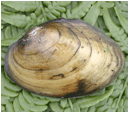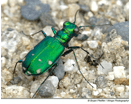Home → Fish & Wildlife → Wildlife → Species Information → Invertebrates
Invertebrates




Photos top to bottom:
Monarch
(photo by Bryan Pfeiffer)
Seaside Dragonlet
(photo by Bryan Pfeiffer)
Yellow Lampmussel
(photo by Ethan Nedeau)
Tiger Beetle
(photo by Bryan Pfeiffer)
As is true globally, invertebrates dominate Maine’s biota in terms of species richness and biomass. Based on available data, MDIFW estimates conservatively that Maine is home to over 16,000 species of terrestrial and freshwater invertebrates, from beetles and butterflies to mayflies and mussels, to name just a few. Coordinating survey, research and conservation priorities for such a diverse suite of organisms is challenging! The best-studied phyla in Maine, as in most states, are the Mollusca (snails and mussels; ∼200 species) and Arthropoda (e.g. insects, crustaceans, spiders; ~7,950 species). Within these phyla, the state of knowledge on distribution, status, and life history is strongest for just three orders: the Unionoida (freshwater mussels), Odonata (damselflies and dragonflies), and Lepidoptera (butterflies and moths), or what some have referred to as the “charismatic microfauna” of the invertebrate world.
One of MDIFW's highest priorities is to address the protection and recovery needs of invertebrates currently on the state's official list of Endangered and Threatened species (21 of 57 species). Some rare invertebrates, such as the Katahdin Arctic Butterfly and Roaring Brook Mayfly, are state or regional endemics – found nowhere else in the world but in Maine or a small area of the Northeast. MDIFW’s Reptile-Amphibian-Invertebrate Group works to ensure that these and other less familiar but ecologically important species remain a part of Maine’s rich natural heritage.